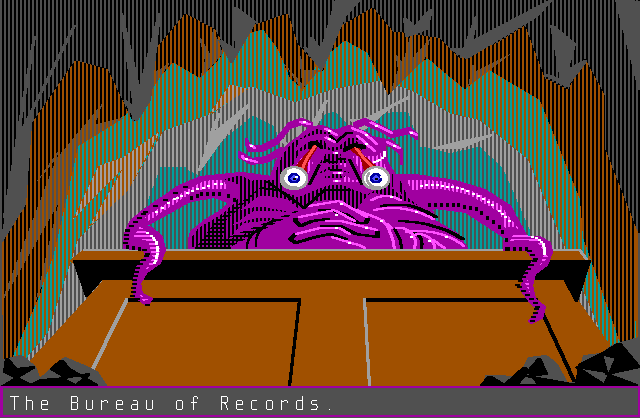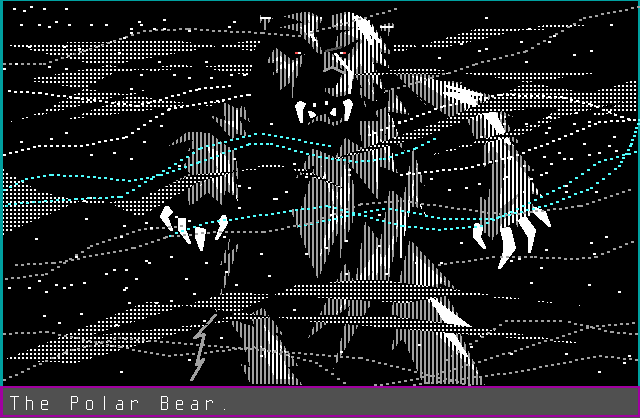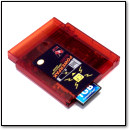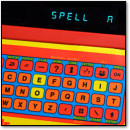Huge Gallery of Prodigy MadMaze Screenshots Now on Flickr
April 7th, 2017 by Benj EdwardsJust a few minutes ago, I released the first group of images from the Prodigy Preservation Project on Flickr. They’re screenshots from MadMaze, a vintage online game that ran on Prodigy Classic between 1989 and 1999.
Specifically, they’re all the graphics from the Place of Power instances in the game. I believe most, if not all, of the artwork was done by Al Sirois, a Prodigy staff artist. Al Sirois did some of the artwork, but Sirois says that most of it was created by other artists (see comments below). They originated as NAPLPS vector graphics (scalable to any size) and were captured into a raster format for display on the web.
Of course, you can play a re-creation of MadMaze yourself on this very server right here. And you can read more about that re-creation (and report bugs you may encounter) here.
If you’d like to support the Prodigy Preservation Project and all of my history work, please consider submitting a pledge on Patreon. Any money I get from Patreon helps a ton toward giving me the extra time to work on history projects like the PPP.








April 7th, 2017 at 3:58 pm
Benj, I did do *some* of the MadMaze art, but relatively little. Most of it was done by John Prusinski, if I remember correctly. If my Prodigy work is notable for anything, it would be for IGGY’S ALMANAC, my twice-weekly “animated” feature.
Thanks,
Al Sirois
April 7th, 2017 at 4:02 pm
Thanks for clarifying that, Al. I’ll update the gallery.
April 7th, 2017 at 4:03 pm
In looking at the screenshots, I think that I did execute the Elven Wood and the Sage’s House, but I am not absolutely sure. John did a lot of the others, and I think that Gregg Smith did some, as well as Kathy Prusinski. Bette Herod may have done some, too.
April 7th, 2017 at 4:05 pm
Al, while you’re here in the comments, would you like to talk a little bit about the process of how you created your Prodigy art? I.e. The tools, the direction, the procedure?
April 8th, 2017 at 4:46 pm
We usually received assignments from our supervisors, and worked with a pool of copywriters, or in the case of the Editorial Department, news and feature writers. We started out using a NAPLPS editor on big dedicated machines (12″ floppies) but eventually graduated to a pc-based editor, which made life a lot easier. The goal was to keep the byte count down as much as possible so that a given page would paint faster. I don’t recall what the limit was, but it was often a real challenge to make things look good inside that limit. The graphic elements appeared on screen in order of creation, so you had to be careful that later elements didn’t overwrite earlier ones — unless that was the intent. And there were timing loops that artists could use to “animate” the graphics by covering up earlier elements with later ones that appeared after a given period of time, and then adding new elements so that the earlier picture seemed to have moved. It could be a very time-comsuming process.
April 9th, 2017 at 11:59 am
Al forgot to mention 2 pieces of amazing NAPLPS for my multimedia project: (1) “Here is your brain…” and (2) “Here is your brain on Multimedia!”. I worked for prodigy fo 8 1/2 years and frequently went to the master, Al Sirois for everything Graphic. In fact when Prodigy turned its attention to the Internet (sort of), Al provided me with wonderful GIF graphics for my first website… LA on the Web.
April 10th, 2017 at 9:46 am
By the way, Al. I really appreciate the Iggy cameo in Mad Maze. I think that’s wonderful.
April 30th, 2017 at 4:33 pm
Lame to interrupt a much more interesting sequence of comments than this, but I’m curious if anyone knows what the Prodigy font/s was/were? I’m most curious about the MadMaze wall-of-text font, which nothing I’ve found today gets exactly right — it has a combination of ‘w’, ‘t’, ‘l’, ‘i’, and ‘A’ styles that just aren’t found together in other monospaced fonts I’ve looked at.
Out of sheer boredom, I’ve started re-creating it from scratch based on MadMaze screens, for what characters I can find, but I’d drop the project if I knew this was readily available somewhere still.
May 1st, 2017 at 9:10 am
Shubs,
As far as I know, it’s a custom font developed for Prodigy. Although it may share its lineage with an earlier design that was part of the NAPLPS graphics display protocol standard.
Whatever it is, it is unlikely to be available as a TrueType font or other modern font type, so if you’d like to re-create it, that would be very cool.
May 2nd, 2017 at 3:41 am
Sure, I’ve never made a font before, so it’ll be fun to try. My first pass in a [what I quickly realized was a woefully subpar] web tool helped me figure out size and spacing, at least:
http://imgur.com/ZTR6Wgv (almost perfect, right?)
But I’ll probably bite the bullet and do it over in FontForge. It’ll give me something to do during my next play-through of the game (gather characters).
There DOES seem to be a bit more to it than just your typical old-school font, seeing how scaling and spacing differs in various other Prodigy screenshot. That might be a little too much for me, but I’ll at least get the MadMaze part.
How’s “Vauxmartin” for a font name? 😛
May 2nd, 2017 at 3:57 am
A slightly more spur-of-the-moment sample, so it doesn’t look like I just tweaked a screenshot. XD
http://i.imgur.com/JW0dPpy.png
May 2nd, 2017 at 9:30 am
Wow, that’s really good, Shubs. I am very impressed. 🙂
May 3rd, 2017 at 2:07 am
Well, so apparently a whole pack of TTF fonts are included in an old Prodigy for Windows installer I found, and they sure do look the part. To my eyes, the 6×10 variant looks most likely to be the common MadMaze font (5×10 is very “A wall is closing behind you!” ish).
If you have access to a Prodigy for Windows install diskette/CD image, they’ll likely be staring you right in the face. Short of installing it on a 16-bit capable system, each *.TT_ file can be expanded with a tool like 7zip, and the resulting file renamed to .TTF to be usable.
I’d upload them and share a link, but that comes a little close to distributing copyrighted files, so I’m hesitant.
May 3rd, 2017 at 2:16 am
Ah, yup. ProdigyMSixByTen set to 16 with no smoothing is exactly it. Welp. I quit! =)
May 3rd, 2017 at 8:46 am
Shubs, that’s a great discovery. Sorry you had to re-do some work that was already done. But if you hadn’t been interested in it, we probably wouldn’t know about the fonts in the Windows client.
Don’t worry about distributing the fonts; literally no one will fault you for it, and history and culture will benefit greatly from it. So there’s your cost/benefit analysis for you. 🙂
May 8th, 2017 at 2:54 pm
FYI, the MadMaze link has a trailing double quote as part of the url in this article and is broken.
That being said. I have really enjoyed playing through it again!